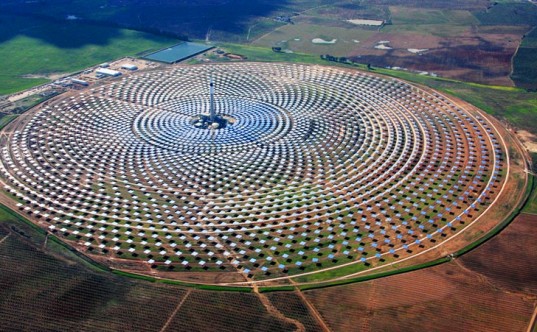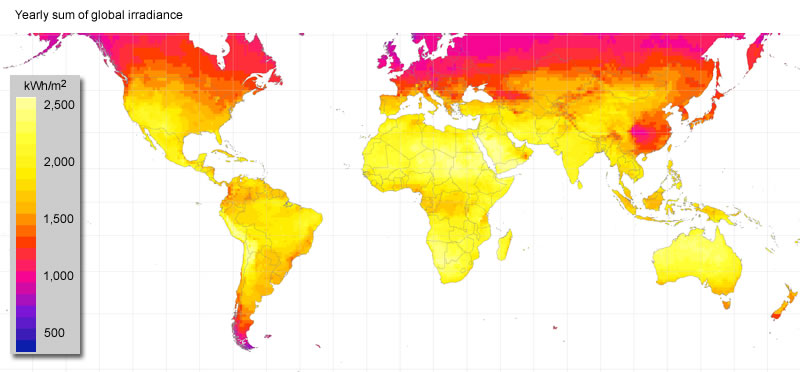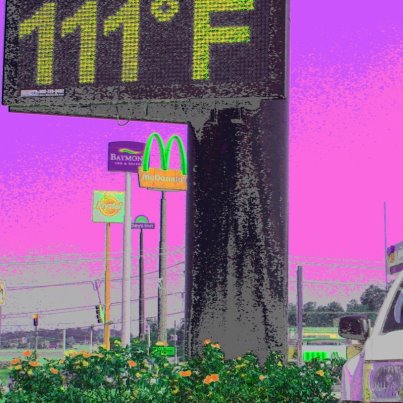We have as much sun in south Georgia as southern Spain, where they’re building industrial scale solar plants.
Tafline Laylin wrote for Inhabitant, 17 July 2011, Spain’s Gemasolar Array is the World’s First 24/7 Solar Power Plant!,
Torresol Energy has overcome one of solar energy’s biggest challenges:  operating when the sun doesn’t shine. The 19.9 MW Gemasolar concentrated solar power plant in Spain’s Andalucia province has two tanks of molten salt (MSES) that store heat energy generated throughout the day. Unlike normal plants that have less thermal storage or none at all, this stored energy enables Torresol to satisfy peak summer energy demand long after sunset.
operating when the sun doesn’t shine. The 19.9 MW Gemasolar concentrated solar power plant in Spain’s Andalucia province has two tanks of molten salt (MSES) that store heat energy generated throughout the day. Unlike normal plants that have less thermal storage or none at all, this stored energy enables Torresol to satisfy peak summer energy demand long after sunset.
So we already know how to store solar power, even without
developing better batteries.
There’s more in the article. About that plant:
Characteristics of Gemasolar:
- Rated electrical power: 19.9 MW
- Net electrical production expected: 110 GWh/year
- Solar field: 2,650 heliostats on 185 hectares
- Heat storage system: the molten salt storage tank permits independent electrical generation for up to 15 hours without any solar feed.
185 hectares is about 457 acres, or about one VLCIA industrial park.
Seville, Spain, is about 37 degrees north latitude. We’re at about 31 degrees. In other words, Seville is about 360 miles north of us. And we get about the same amount of sun as Seville does.

The average insolation (amount of sunlight falling on the surface) in Seville, Spain is about the same as in Valdosta, Georgia: about 4.85 kWh/m2 per day.
 Here’s a month-by-month comparison using Solar Electricity Handbook 2012 Edition. They haven’t heard of Valdosta, so I used Macon. You remember Macon, where it was
110 degrees June 30th.
Here’s a month-by-month comparison using Solar Electricity Handbook 2012 Edition. They haven’t heard of Valdosta, so I used Macon. You remember Macon, where it was
110 degrees June 30th.
| When | Jan | Feb | Mar | Apr | May | Jun | Jul | Aug | Sep | Oct | Nov | Dec |
| Seville |
4.16 |
4.76 |
5.68 |
5.81 |
5.98 |
6.49 |
6.90 |
6.77 |
6.01 |
4.78 |
3.96 |
3.63 |
| Macon |
3.76 |
4.24 |
5.03 |
5.52 |
5.58 |
5.16 |
5.24 |
5.07 |
4.84 |
4.96 |
4.18 |
3.73 |
Some months, Sevilla has a bit more sun. But in part of the fall, we have more sun.
Maybe we should start thinking bigger around here. And if we’ve got the sun for a big solar plant, we’ve got the sun for a lot of little rooftop solar panels.
How about if we put Valdosta, Lowndes County, and south Georgia on the solar map so everyone will hear of us?
-jsq
Fox News recently claimed that “solar won’t work in America because it’s not as sunny as Germany”. Such statements are common for a network that has long lost its credibility. Unfortunately too many take such gibberish at face value. Thus columns like “environmentalism or obstructionism?” are not surprising, but in the end it’s the facts that matter:


